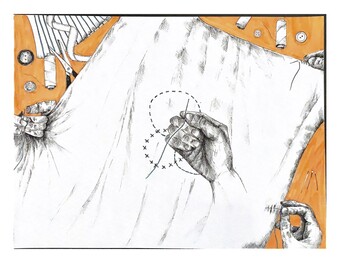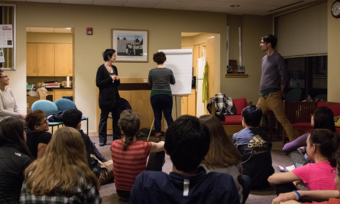The Value of Rhythms
I live between two rhythms.
One rhythm comes from my professional life. I have worked almost my entire life in the context of institutions, large and small and I have been beholden by their sense of time, and process—anticipation driven by a clock and federal holidays. At the surface, these rhythms are easy to see. They include:
- Workdays of at least eight (8) hours, 9 A.M. to 5 P.M., with sixty hours being a normal work-week. More work hours will be required as the work dictates.
- All time off to be requested in advance, with the exception of sick leave.
- Since sick leave cannot be scheduled in advance, don’t get sick.
- Attend all scheduled meetings all day and several unscheduled meetings as needed.
- Vacation and sick hours not to exceed the allotted time allowed for vacation and sick hours, but better not think of taking more than a few days off at a time.
- When it gets busy, kiss your vacation time goodbye.
- Conduct and submit to annual performance evaluations.
- Purchase a cake for employees on their birthdays. Be prepared to sing.
But in my personal life, I often fall outside of institutional rhythms and rules. My inability to conform to the institutions of gender and sexuality has made a mess of the rhythms we call rites of passage, such as:
- Picking out a wedding dress.
- Planning a wedding.
- Having children.
- Celebrating holidays with “in-laws.”
- Filling out forms to affirm my identity.
This is all a long way of saying that I have a love/hate relationship with institutions. They function as a salve of security if you’re inside them, and they keep you peering through their big glass windows contemplating whether it’s worth trying to get in if they deem you “other” and unworthy.
They function as a salve of security if you’re inside them, and they keep you peering through their big glass windows contemplating whether it’s worth trying to get in if they deem you “other” and unworthy.

Rhythms of Artists Versus Rhythms of Institutions
In my experience those folks we label “individual artists” have about as much in common with the rhythms of large producing institutions as I have in common with the institution of marriage. And I'm aware of two trends in our field right now that pertain to these two contentious terms—"individual artist" and "institution."
1. It seems that leaders of some large institutions don’t want us to talk aloud about the relationship between the two and certainly don’t want us to draw distinctions. We all need to just support the larger idea of theatre and not tarry over who makes more money.
2. The dialogue between the two entities is heating up like never before—just check out Diane Ragsdale’s Jumper blog. My guess is these things are related—efforts to silence tend to lead to a Freudian repression—the silence becomes unspoken excess that starts to ooze out in various forms of neuroses all over the place. I feel covered in ooze.
In a helpful exchange about all of this, my former boss Martha Lavey, artistic director of Steppenwolf Theatre, provided me with the term rhythm. Institutions are framed in the kinds of business rhythms I list above, and artists, at least the ones I know, have to keep one full foot if not both feet outside of institutional rhythms to imagine things that have yet to be framed. As Lewis Hyde says,
For the slow labor of realizing a potential gift the artist must retreat to the Bohemias, halfway between the slums and the library, where life is not counted by the clock and where the talented will be sure they will be ignored until that time, if it ever comes, when their gifts are viable enough to be set free and survive in the world.
Most of us who work in theatre believe that there’s something “other worldly” about the work of the artist. If you read and enjoyed Tolkien’s The Lord of the Rings, in junior high the way I did, you can’t help but value greatly the truth that the artist must retreat to the Bohemias, so that there is time to imagine new worlds, new ways of seeing and believing.
But exactly what do the Bohemias have in common with institutional rhythms?
Not much.
A conversation I've had many times with an individual artist:
Carl: In exchange for this fellowship I'm going to offer you I need you to make several commitments to my institution. These include: attending a donor event, coming to staff meetings this year, reading scripts for the next round of fellowships, and oh—please respond to my emails when I send them.
Artist: Yes! I'm so excited to do all of these things. Yes! Yes! Two months later an email exchange:
Carl: Hey!!!!!! Yo!!!!!!! I miss you. Where are you? Are you still working on that show in Antarctica? I totally need you to be auctioned off at this donor event in a couple of months. We auction you off to write this play for this rich person....
Artist: Polly!!!!!!! Great to hear from you!!! I would LOVE to be auctioned off. But HUGE drag, I'm at McDowell that month. Damn! Next time count me in for sure!
Okay, a couple of things about this bogus exchange—sometimes the artist will say yes, clearly the artist and I love each other and clearly I feel let down by the artist because I have to go to that stupid fundraiser and auction off playwrights when I would rather be at McDowell. Oh, and neither of us use that many exclamation points.
The truth in this exchange is that we view our rhythms as a trade off and to some degree we both think the other's grass is greener. I desire the free time to write and think and imagine, and to say “no” to things so that I can do other more interesting things. My individual artist friends desire regular paychecks and the security that provides.
I desire the free time to write and think and imagine, and to say “no” to things so that I can do other more interesting things. My individual artist friends desire regular paychecks and the security that provides.
So What?
Even as I write this essay, I think, “So What? Artists and Institutions have different rhythms?” Saying this is no different than saying our personal and professional lives have different rhythms, and still, we find a way to reconcile these differences into a thing we call a life. Why can’t we find reconciliation between the institutions that exist in part to serve artists (also audiences and communities) and the artists who make institutions matter?
And then I have my own epiphany. It’s the weekend mind you, and I’m in my version of Bohemia—biking and walking and sitting on my deck overlooking the city of Boston and reflecting on why we divided our field up between artists and institutions in the way we have. And I realize as I’m writing this essay on rhythms that the issue isn’t really about rhythms between artists and institutions, but about rhythms between disparate kinds of institutions, some which serve artists better and live more ethically in the world.
In fact if you look at the comments section on Diane’s blog post for example, it’s really not a conversation between individual artists (I see a few represented there) and institutions, but between different institutional leaders with wildly different viewpoints about the purpose and role of institutions in our field.
And these different viewpoints are driven by completely opposing rhythms. Those perpetuating the ongoing life of a LORT theatre for example, must live by the rhythms driven by filling large numbers of seats, maintaining very high cost overheads, and convincing people that paying a lot for a ticket is worth it. These rhythms are very particular and are different from an institution whose sole purpose is to maintain a development laboratory for new work. Both institutions will claim they love artists, because they do.
But we institutional types might all benefit from more time in the Bohemias together to figure out just what we’re saying. Because what’s noteworthy in all of this for me are two things:
1. Artists aren’t in these conversations as vociferously because they need both types of institutions. They can’t take any risk in cutting themselves off from the large institutional theatres no matter how mad issues of disparity and access make them. And they desperately need those artist-centered, usually smaller institutions that accommodate their rhythms more easily.
2. Rhythms have values and hence institutions do too.
Rhythms Have Values
Recently Lynette and I were told that we have to get married. In order for her to remain on my health plan at Emerson. We have six months to tie the knot. This is both a great thing and completely weird because I have such a fraught relationship with the institution of marriage. Most of my life, I felt enraged by the heterosexual mirror and couldn’t believe so many gay people were fighting to be let into such a bankrupt institution. Then I met Lynette D’Amico and about thirteen years into our relationship, realizing I would never love another in this way, I suddenly wanted to go through that rite of passage and shout my love to all of my family and friends. I proposed. But I wasn’t expecting to then be told by an institution when it all had to happen.
So now Lynette and I are in a frenzy driven by a bunch of institutions, Emerson, the State of Massachusetts, and our extended families.
Most of my life, I felt enraged by the heterosexual mirror and couldn’t believe so many gay people were fighting to be let into such a bankrupt institution.
And we have to make some decisions about our values. The first relates to how much we value health insurance. This is a decision individual artists make everyday as they choose between their time in the Bohemias and institutional day jobs. Other value based decisions will include how accessible and transparent and inclusive our wedding will be and how much we think is too much to pay for that inclusivity.
Well, you get the point. Our choices about how we enter the institution of marriage will be value-driven and we’re both clear that our rhythms will have to change as we consider how to incorporate this new institution into our life.
And I’ve been saying for awhile now that it’s time for all of our institutions to ask the very hardest kinds of questions about our values. Do we value artistic work in our institutions for its own sake? Are we willing to pay artists to be artists whether or not they write a play that delivers box office returns to the theatre? Do we believe that artists, who spend their lives outside the demands of time clocks and performance evaluations, should be paid less a result? What values do our day-to-day rhythms promote?
It’s this question of values that we’re not pushing ourselves hard enough to consider as we move to the beat of our institutional rhythms. We don’t spend enough time away from those rhythms and the pressures they bring, to think about new institutional models that can lead to new and healthier relationships between individual artists and institutions.
And as artists, what part of your creative lives must be turned toward reimagining our institutions? When must you leave the Bohemias to give us a hand and help us create new frames and stories for our organizations?
As I contemplate joining the institution of marriage, I will consider this question of rhythms—where to hold onto existing values (I am not buying a dress!) and where to invite new values into my daily rhythms.















Comments
The article is just the start of the conversation—we want to know what you think about this subject, too! HowlRound is a space for knowledge-sharing, and we welcome spirited, thoughtful, and on-topic dialogue. Find our full comments policy here
Great post and a very important topic. I often say business
goes bop, bop, bop, bop, bop, and art goes ….. ….. ….. BANG! I am an individual
artist, director, actor, and clown. And I have infiltrated arts administration.
It is the way I can fund my projects, create opportunity for myself and advance
my artistry. It is so much easier to find money for administration then it is
for projects. Of course it is not easy to find money for administration but
simply easier. I am the Executive Director of Portland Actors Conservatory and a
company member of Third Rail Repertory theatre, both in Portland Oregon.
Company membership in Third Rail comes with the responsibility of doing the
business of the theatre, and being Executive Director of the Conservatory comes
with…well… all of the things an executive director needs to do! Both
institutions are run completely by artists. We struggle with doing the business
of the institution (what institution doesn’t) but we recognize that artists
have great project based skills and when held accountable are able to implement
innovative business practice. Of course both institutions make time for day
dreaming, disappearing for coffee or drinks and to wait for inspiration. But we
hold people accountable for their work. I think our larger theatre institutions
need to make more room for artists within their administrations. Find ways to
hire artists: hire actors for a season and task them as actors for part of the
season and task them with business projects the rest of the season; ask
directors to pitch play ideas in writing and submit project grant proposals,
etc. Give the artist institutional ownership. I think individual artists need
to infiltrate our larger theatre intuitions. Find a way to get hired: offer to
read plays for the literary manager; become a production assistant in the marketing
department, etc. Put yourself, as an artist, inside the institution. The more
individual artists are inside the institutions the less we can separate and
delineate between the two.
So I just produced this convening of Young Theater Makers in the Bay Area and it was really interesting seeing some of this discussion come up in a group of twenty-somethings. This might sound reductive but it was kind of like the kidz table version of the conversation the adults are having.
In a lot of ways it was really awesome because it showed that the interns, fellows, and students, are seeing all of these issues and are already trying to find out what our contribution is going to be to the restructuring of American theater.
That being said it made me a little nervous that this was beginning of our generation's rounds of conferences and convenings rehashing the same conversation. Follows by leaving the conversation with awesome ideas and then falling back into the pattern. These structured conversations are kind of like the middle ground between bohemia and institutional Mordor (thanks for opening the conversation to LOTR references) - where administrators and artists can come together and really brain storm beautiful visions, but what I wonder what will be the catalyst? Will it be a change in the big institutions, artists moving outside of the system, or is it a new generation bringing a different way of thinking?
These and other fragmented thoughts are what keep me up at night causing one pretty unhealthy rhythm.
Kevin! This is such a thoughtful set of questions. Thank you. I remember almost ten years ago now sitting with a group of my peers, all in our 30s asking "when it would be our turn?" We saw things differently than many of the institutional leaders ahead of us and we wanted our chance to impact the direction of our field. Ten years later, mostly the same institutional leaders are leading and those peers in their 30s are still waiting for their chance to lead and change. While they wait, they perpetuate these institutional models, because what else is there to do? What I'm struck by is the need for entirely new leadership models that bring together the incredible experience of our existing leadership and incorporate the voices of the generations behind. As the world is changing, it's time for the theater to catch up...
There is always the danger (or pleasure) of
getting lost in semantics, but there are so many ways in which institutions
need to be analyzed. I love Winter’s comments. Polly’s material critique is of
course essential.
Are there models as to how institutions can
function positively for everyone they affect? Even putting remuneration aside? Hospices
come to mind. It seems that in the current state of things most institutions exist
to serve themselves, to keep themselves afloat. They need to try to keep going,
obviously (and so far, cultures seem to demand institutions), but is that their
purpose? I think administrators of
theatres would argue that their institutions are designed to serve audiences. But are they really designed to serve audiences?
What/which audience? Obviously there is a problem with serving audiences. Or how about that buzz word, communities?
Which communities, and how? If they really were designed to serve communities
how would this affect the work they do? What kinds of stories would they tell? What
would the criteria be for choosing the stories? Going local, going global? Risking
the untried? Participation in the furtherance of the art form? Celebrating
humanity in all its variety? And what about the price of tickets?
And what if theatres were designed to serve
artists? What would that look like? How can theatres serve artists better? Should artists become part of the institutions,
themselves? There are models for this. And/or can institutions recognize the
needs of artists to remain outside the bounds (and rhythms) of institutions and
serve them where they are? Obviously
there is a problem with institutions serving artists. While recognizing that
the running of an arts institution is a complex juggling act in this day and
age, I think a sense of purpose and true service has been lost. Tales come back of
artistic staff ‘falling in love’ with certain plays. Leaving cynicism aside, is
that purpose? Does that serve artists? Audiences? But back to the hospice.
Hospices are designed to serve people who are
dying-- with compassionate care, the easing of their pain. That’s a very clear
purpose. For most outside the profession, theatre is a dying art. Can theatre institutions
find renewed purpose beyond their own survival? And if theatres are on their
way to extinction, let them be compassionate and caring for their audiences and
artists on the way out.
Lydia, you're asking so many good questions here! And I want to think more about what other models of institutions are there that as Winter says have generosity and compassion and inclusiveness and transparency built into them.
Polly - great post! I, too, have been wondering whether "institution" versus "artist" is the right way to frame the conversation. I think you are right that different "rhythms" and "values" between institutions (and also between institutions and the individuals they choose to "serve", so to speak) are a big part of this. It seems we're not going to get very far in this conversation until we can acknowledge that we are not ‘one theater’, we are not ‘one tribe’. Indeed, we have a nonprofit American theater that is made up of organizations with very different practices driven, in many cases, driven by competing (not complementary) values and ideals--and serving, or orienting our institutions around, very different stakeholders. There has been a tendency (among funders, the field generally, the press, etc.), I think, to see the "resident theater/LORT" model as the "standard" for nonprofit professional theater, or the ideal, and everything else as a less evolved incarnation of theater--as though we are all headed in the same direction but have different paths for getting there. But I think this belies the fact that these "other" models (whether they be theater ensembles, or artist-focused labs, or community-based theater, political theater, etc.) have values that are fundamentally opposed, in some cases, to the values of resident theaters. Generally speaking, since the 80s, we have not tended to give these alternative values (and corresponding rhythms?) their due. (It might be a good moment to point out that the Network of Ensemble Theaters began, as I understand it, because even though ensembles were eventually invited to the TCG party they didn't feel that their needs, practices, values, or rhythms were accommodated or understood by the LORT-oriented membership organization.) There is a great tendency to want to smooth everything over and say that we all come together under a big tent called "the magic of storytelling" or something like that. But we are not all fighting for the same cause—nor should we be, necessarily. We do not need to come to agreement on a purpose for the nonprofit theater to move forward; but it is possible that we cannot move forward until we can acknowledge and respect these important differences and discuss what they mean for our sector. Thanks, again, for the great post.
Diane, you've said what I was trying to say even more clearly. I realize that we keep talking about these two entities -- artists and institutions -- like it's those entities that are at odds. But in fact, it's really different kinds of institutions that are at odds about how to make homes for artists. And for the most part, artists really aren't in the artist/institution debate, institutional leaders are.
Polly! You ask such IMPT questions. One thing I've been thinking about is grouping as institution. EG at what point does the designation "Latino" become a kind of institution with an intrinsic set of aesthetic and structural expectations and how can we both find power in numbers while maintaining distinct identities
Hey Lisa,
This is exactly what I wrote my Ph.D dissertation on, but as pertains to the GLBT question of identity that was shaping itself around institutions and academic programs. Would love to discuss this with you more sometime as I think about all of the academic programs that emerged in the 70s and 80s around identity and how they have struggled to maintain relevance in part because of the divisiveness that emerges inside those identity categories.
Great article. As an emerging artist I am constantly learning about the delicate relationships, or rhythms, in the theatre world. I think the idea of having a conversation about values and where they lie is very important, on grand and small scales. Especially when it comes to artists and how much they are valued in a institutional setting (where the institution holds health care over their heads). Thanks for the read. Good luck on the wedding.
Thanks for this comment Taylor. Exactly the right question -- do we value the rhythms of artists given that they tend not to be linear?
Great questions. I'd like to add another rhythm into the mix: the university. As a theatre educator, I try to engage my students in negotiating the relationship between the world as it is and the world as it could be.
Yes! Something I'm thinking a lot about now that we've arrived at Emerson. You should write a HowlRound post about this!
The connotation of the word institution is generally negative; institutionalized racism, institutionalized oppression. An institution is the place where the "insane" are sent. Do you hear of institutionalized generosity, institutionalized compassion. Which institutions applaud individual and/or collective integrity? How about bravery? Where would an institution seeking collective compassion begin?
Winter, this an important point. And it seems to me there is value in expanding our notion of institutions to represent values and ethics and the things you mention, like generosity and compassion because many of hte ways people come together does happen around institutions.
I like this idea of rhythms and often feel myself conflicted about the rhythms of my life..there is the rhythm of the artist and institutions, and the rhythms of academia and of parenthood too, to contend with. Regarding being a playwright and a mother, I figured out early on there was no balancing these two diametrically opposed rhythms. The answer for me was to keep moving forward, writing the next play, not to worry if I was moving slowly, just so that I was moving in the direction of that next play. In the long run I wrote plays and raised kids, and each of these vocations defined both the parent and the artist. Maybe there's a model in here for this conversation? I don't think there is such a thing as balance as a mother/writer. Sometimes you're a better mother, sometimes you're a better artist, but as long as you keep moving forward, unwilling to compromise either....in the end you might come out with a body of work and amazing human beings at the same time. With artists and institutions the goals are more in line with each other, creating good work for the theater. I think its possible for different rhythms to feed each other better without compromising the artistic or institutional goals of either.
Vital questions, richly drawn. I expect a lot when I start a new HowlRound article, and I'm so rarely disappointed. Beautiful work, as usual, Polly.
Thanks Eric!
Agreed
Eric - insightful as always. I think we also have to factor in the rhythms of
the "outside" world - the ups and downs of the economy, the
see-sawing of conservatism vs. liberalism, and the swaying attitudes towards
the importance of the arts caused by these changes, be they real or perceived,
by the patrons and funders
we depend upon for support.
Thank you for putting out this word--rhythm. It gives me good visual image for how these two seemingly competing parts of my artistic life (and brain) can actually exist and run alongside each other. Thank you!
This is a great examination of the conflicts between different rhythms, and definitely an important conversation to be having. Another factor you didn't explore is the effect conflicting rhythms can have on each other. I work full time in an LORT theater (and consider myself very lucky to do so) while simultaneously working as a playwright. These two aspects of my life (call them the "creative" and the "institutional") have distinct rhythms of their own, and they rarely, if ever, work together. I am often faced with the choice of pursuing a path that would be better for the professional development of my institutional side, but at the expense of my creative side, or vice versa. Occasionally the struggle is enough to flirt with the idea of giving one of these aspects up and simplifying everything, but I know that, for me, this would never work to my satisfaction. I define myself as a playwright, but I also need to support myself. I entered into this field having no expectations of ever making a living (which is its own conversation) and, at the moment, being able to make a living within the field is enough, but I wonder how much longer I can continue juggling these conflicting rhythms before one of them gives way. It's a delicate balance, and one that I'm sure countless other artists who are fortunate enough to have full time jobs (in the arts or elsewhere) have to deal with constantly.
Thanks for this thoughtful comment Scott. I understand the balance you're trying to achieve both personally and as a result of so many artists I talk to everyday trying to sort it out. I keep thinking that there must be a way to make one's institutional life more accommodating to those artistic rhythms so balance is possible within the institution.